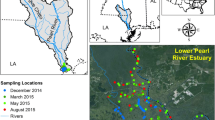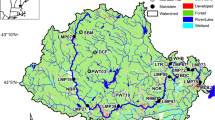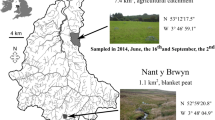Abstract
Dissolved organic matter (DOM) is a central driver of many processes in aquatic environments. Here, we address the issue of spatial and temporal variations in DOM quantity and quality in a deep tropical lake (Brazil). We measure DOC, Chl-a, suspended solids, nutrients and CDOM metrics in surface water samples taken from 21 sampling sites during six campaigns, and we quantify their links with water depth and rainfall estimates. Temporal effects explain between 74.5 and 94.5% of the variance in DOC, SUVA254, aCDOM440, and Chl-a, and all those parameters were influenced by rainfall. In contrast, spatial variations affect more S275-295 and aCDOM254. The contributing drainage area varies spatially in morphology and geometry, and each portion affects a specific part of the lake, resulting in a spatial variation in DOM quantity and quality. Our findings demonstrate the importance of the input of allochthonous DOM (which depends on seasonal rainfall and drainage area shape) to DOM dynamics in a tropical lake. The study area is receiving lower rates of precipitation in recent times, and our results suggest that this may alter the seasonal patterns of input of DOM and nutrients in the lake, with possible impacts on water quality, aquatic biota and ecosystem functioning.

source: Sentinel-2B Imagery (12-m resolution; year: 2019)



Similar content being viewed by others
References
Amon RMW, Benner R (1994) Rapid cycling of high molecular weight dissolved organic matter in the ocean. Nature 369:549–552
APHA (1998) Standard methods for the examination of water and wastewater. APHA, Washington
Barbosa FAR, Tundisi JG (1980) Primary production of phytoplankton and environmental characteristics of a shallow quaternary lake at Eastern Brazil. Arch Hydrobiol 90:139–161
Barros CFA, Souza MBG, Barbosa FAR (2006) Seasonal forces driving phytoplankton size structure in a tropical deep lake (Dom Helvécio Lake, South-East Brazil). Acta Limnol Bras 18:55–66
Battin TJ, Kaplan LA, Findlay S, Hopkinson CS, Marti E, Packman AI, Newbold JD, Sabater F (2008) Biophysical controls on organic carbon fluxes in fluvial networks. Nat Geosci 1:95–100. https://doi.org/10.1038/ngeo101
Benner R (2002) Chemical composition and reactivity. Biogeochemistry of marine dissolved organic matter. Academic Press, DA Hansell and CA Carlson, pp 59–90
Bezerra-Neto JF, Pinto-Coelho RM (2008) Morphometric study of Lake Dom Helvécio, Parque Estadual do Rio Doce (PERD), Minas Gerais, Brazil: a re-evaluation. Acta Limnol Bras 20(2):161–167
Bezerra-Neto JF, Gagliardi LM, Brandão LPM, Brighenti LS, Barbosa FAR (2019) Effects of precipitation on summer epilimnion thickness in tropical lakes. Limnologica 74:42–50
Bittar TB, Vieira AAH, Stubbins A, Mopper K (2015) Competition between photochemical and biological degradation of dissolved organic matter from the cyanobacteria Microcystis aeruginosa. Limnol Oceanogr 60:1172–1194
Brandão LPM, Staehr PA, Bezerra-Neto JF (2016) Seasonal changes in optical properties of two contrasting tropical freshwater systems. J Limnol 75(3):508–519. https://doi.org/10.4081/jlimnol.2016.1359
Brandão LPM, Brighenti LS, Staehr PA, Barbosa FAR, Bezerra-Neto JF (2017) Partitioning of the diffuse attenuation coeficiente for photosynthetically available irradiance in a deep dendritic tropical lake. An Acad Bras De Ciênc 89:469–489. https://doi.org/10.1590/0001-3765201720160016
Brandão LPM, Brighenti LS, Staehr PA, Asmala E, Massicotte P, Tonetta D, Barbosa FAR, Pujoni D, Bezerra-Neto JF (2018) Distinctive effects of allochthonous and autochthonous organic matter on CDOM spectra in a tropical lake. Biogeosciences 15:2931–2943. https://doi.org/10.5194/bg-15-2931-2018
Brighenti LS (2014) Uso de sensores de alta frequência para estimativas contínuas de metabolismo e monitoramento em lagos tropicais. Doctoral thesis, Universidade Federal de Minas Gerais, Belo Horizonte, Minas Gerais, Brazil
Brighenti LS, Staehr PA, Gagliardi LM, Brandão LPM, Elias EC, Mello NAST, Barbosa FAR, Bezerra-Neto JF (2015) Seasonal changes in metabolic rates of two tropical lakes in the Atlantic Forest of Brazil. Ecosystems 18:589–604. https://doi.org/10.1007/s10021-015-9851-3
Burrough PA, McDonnell RA (1998) Principles of GIS. Oxford University Press, London
Camargos VL, Silva AF, Neto JAAM, Martins SV (2008) Influência de fatores edáficos sobre variações florísticas na Floresta Estacional Semidecídua no entorno da Lagoa Carioca, Parque Estadual do Rio Doce, MG Brasil. Acta Bot Bras 22(1):75–84. https://doi.org/10.1590/S0102-33062008000100010
Catalán N, Obrador B, Felip M, Pretus JL (2013) Higher reactivity of allochthonous vs autochthonous DOC sources in a shallow lake. Aquat Sci 75(4):581–593. https://doi.org/10.1007/s00027-013-0302-y
Farjalla VF, Marinho CC, Faria BM, Amado AM, Esteves FA, Bozelli RL, Giroldo D (2009) Synergy of fresh and accumulated organic matter to bacterial growth. Microb Ecol 57(4):657–666. https://doi.org/10.1007/s00248-008-9466-8
Fonte ES, Amado AM, Meirelles-Pereira F, Esteves FA, Rosado AS, Farjalla VF (2013) The combination of different carbon sources enhances bacterial growth efficiency in aquatic ecosystems. Microb Ecol 66(4):871–878. https://doi.org/10.1007/s00248-013-0277-1
França GS, Stehmann JR (2013) Florística e estrutura do componente arbóreo de remanescentes de Mata Atlântica do médio rio Doce, Minas Gerais Brasil. Rodriguésia 64(3):607–624
Fulton JR, McKnight DM, Foreman CM, Cory RM, Stedmon C, Blunt E (2004) Changes in fulvic acid redox state through the oxyline of a permanently ice-covered Antarctic lake. Aquat Sci 66:27–46. https://doi.org/10.1007/s00027-003-0691-4
Hedges JI (1992) Global biogeochemical cycles: progress and problems. Mar Chem 39:67–93
Helms JR, Stubbins A, Ritchie JD, Minor EC, Kieber DJ, Mopper K (2008) Absorption spectral slopes and slope ratios as indicators of molecular weight, source and photobleaching of chromophoric dissolved organic matter. Limnol Oceanogr 53:955–969
Jaffé R, McKnight D, Maie N, Cory R, McDowell WH, Campbell JL (2008) Spatial and temporal variations in DOM composition in ecosystems: the importance of long-term monitoring of optical properties. J Geophys Res 113:G04032. https://doi.org/10.1029/2008JG000683
Kieber RJ, Whitehead RF, Skrabal SA (2006) Photochemical production of dissolved organic carbon from resuspended sediments. Limnol Oceanogr 51:2187–2195
Li J, Heap AD (2011) A review of comparative studies of spatial interpolation methods in environmental sciences: Performance and impact factors. Ecol Inform 6(3–4):228–241
Lønborg C, Álvarez-Salgado XA, Davidson K, Martínez-García S, Teira E (2010) Assessing the microbial bioavailability and degradation rate constants of dissolved organic matter by fluorescence spectroscopy in the coastal upwelling system of the Ría de Vigo. Mar Chem 119:121–129
Mackereth FJH, Heron J, Talling JF (1978) Water analysis and some revised methods for limnologists. Freshwater Biological Association, USA
Maia-Barbosa PM, Barbosa LG, Brito SL, Garcia F, Barros CF, Souza MB, Mello NAST, Guimarães AS, Barbosa FA (2010) Limnological changes in Dom Helvécio Lake (South-East Brazil): natural and anthropogenic causes. Braz J Biol 70(3 Suppl):795–802
Maie N, Boyer JN, Yang C, Jaffé R (2006) Spatial, geomorphological and seasonal variability of CDOM in estuaries of the Florida Coastal Everglades. Hydrobiologia 569:135–150. https://doi.org/10.1007/s10750-006-0128-x
Mattsson T, Kortelainen P, Raike A (2005) Export of DOM from boreal catchments: impacts of land use cover and climate. Biogeochemistry 76:373–394. https://doi.org/10.1007/s10533-005-6897-x
McKnight DM, Andrew ED, Aiken GR, Spaulding SA (1994) Aquatic fulvic acids in algal rich Antarctic ponds. Limnol Oceanogr 39:1972–1979
McKnight DM, Boyer EW, Westerhoff PK, Doran PT, Kulbe T, Andersen DT (2001) Spectrofluorometric characterization of dissolved organic matter for identification of precursor organic material and aromaticity. Limnol Oceanogr 46:38–48
Miller C, Gordon KG, Kieber RJ, Willey JD, Seaton PJ (2009) Chemical characteristics of chromophoric dissolved organic matter in rainwater. Atmos Environ 43:2497–2502
Mueller KK, Fortin C, Campbell PGC (2012) Spatial variation in the optical properties of dissolved organic matter (DOM) in lakes on the Canadian Precambrian shield and links to Watershed Characteristics. Aquat Geochem 18(1):21. https://doi.org/10.1007/s10498-011-9147-y
Neto AR, Da Paz AR, Marengo JA, Chou SC (2016) Hydrological processes and climate change in hydrographic regions of Brazil. J Water Res Prot 8:1103–1127
Read JS, Rose KC (2013) Phisycal responses of small temperate lakes to variation in dissolved organic carbon concentratios. Limnol Oceanogr 58(3):921–931
Read JS, Hamilton DP, Jones ID, Muraoka K, Winslow LA, Kroiss R, Gaiser E (2011) Derivation of lake mixing and stratification indices from high-resolution lake buoy data. Environ Model Softw 26(11):1325–1336
Reynolds CS (2009) Hydrodynamics and mixing in lakes, reservoirs, wetlands and rivers. In: Likens Ge (ed) Biogeochemistry of inland waters: a derivative of encyclopedia of inland waters. Cary Institute of Ecosystem Studies Millbrook, USA
Schwanghart W, Scherler D (2014) TopoToolbox 2–MATLAB-based software for topographic analysis and modeling in Earth surface sciences. Earth Surf Dyn 2(1):1–7
Teixeira MC, Azevedo JCR, Pagioro TA (2011) Spatial and seasonal distribution of chromophoric dissolved organic matter in the Upper Paraná River floodplain environments (Brazil). Acta Limnol Bras 23:333–343
Teixeira MC, Azevedo JCR, Pagioro TA (2013) Photo-degradation effect on dissolved organic carbon availability to bacterioplankton in a lake in the upper Paraná river floodplain. Acta Sci 35:47–54
Thurman EM (1985) Organic geochemistry of natural waters. Martinus Nijoff/Dr W Junk Publishers (Kluwer Academic Publishers Group), Dordrecht
Tian YQ, Yu Q, Ye CJ, Blunden A (2013) Effects of climate and land-surface process on terrestrial dissolved organic carbon export to major US coastal rivers. Environ Eng. https://doi.org/10.1016/jecoleng201301028
Weishaar JL, Aiken GR, Bergamaschi BA, Fram MS, Fugii R, Mopper K (2003) Evaluation of specific ultraviolet absorbance as an indicator of the chemical composition and reactivity of dissolved organic carbon. Environ Sci Technol 37:4702–4708
Wetzel RG (2001) Limnology: lake and river ecosystems, 3rd edn. Academic Press, San Diego
Williamson CE, Stemberger RS, Morris DP, Frost TM, Paulsen SG (1996) Ultraviolet radiation in North American lakes: attenuation estimates from DOC measurements and implications for plankton communities. Limnol Oceanogr 41:1024–1034
Xu-jing G, He L-S, Li Q, Deng-hai Yu, Yuan D (2014) Investigating the spatial variability of dissolved organic matter quantity and composition in Lake Wuliangsuhai. Ecol Eng 62:93–101. https://doi.org/10.1016/jecoleng201310032
Acknowledgements
We thank the Conselho Nacional de Desenvolvimento Científico e Tecnológico (CNPq), Coordenação de Aperfeiçoamento de Pessoal de Nível Superior (CAPES) and Fundação de Amparo à Pesquisa do Estado de Minas Gerais (FAPEMIG) for financial support. Part of the writing of this manuscript was performed in Aarhus University (Roskilde, Denmark), supported by the project Carbon Cycling in Lakes (COCLAKE.—CAPES Proc No. 88881.030499/2013-01). D.P. had support from CAPES under a CAPES-PrInt Postdoctoral fellowship (No 88887.367976/2019-00). We also thank the laboratories LIMNEA and LGAR (Federal University of Minas Gerais, Minas Gerais, Brazil) for their infrastructure and Nelson Mello, Marcelo Costa, and Patrícia Ferreira for all the help in the field and laboratory.
Author information
Authors and Affiliations
Corresponding author
Additional information
Publisher's Note
Springer Nature remains neutral with regard to jurisdictional claims in published maps and institutional affiliations.
Handling Editor: Yuko Sugiyama.
Supplementary Information
Below is the link to the electronic supplementary material.
Rights and permissions
About this article
Cite this article
Brandão, L.P.M., Staehr, P.A., Brighenti, L.S. et al. Rainfall and drainage basin shape strongly control temporal and spatial variation of dissolved organic matter in a tropical lake. Limnology 23, 207–217 (2022). https://doi.org/10.1007/s10201-021-00684-w
Received:
Accepted:
Published:
Issue Date:
DOI: https://doi.org/10.1007/s10201-021-00684-w




